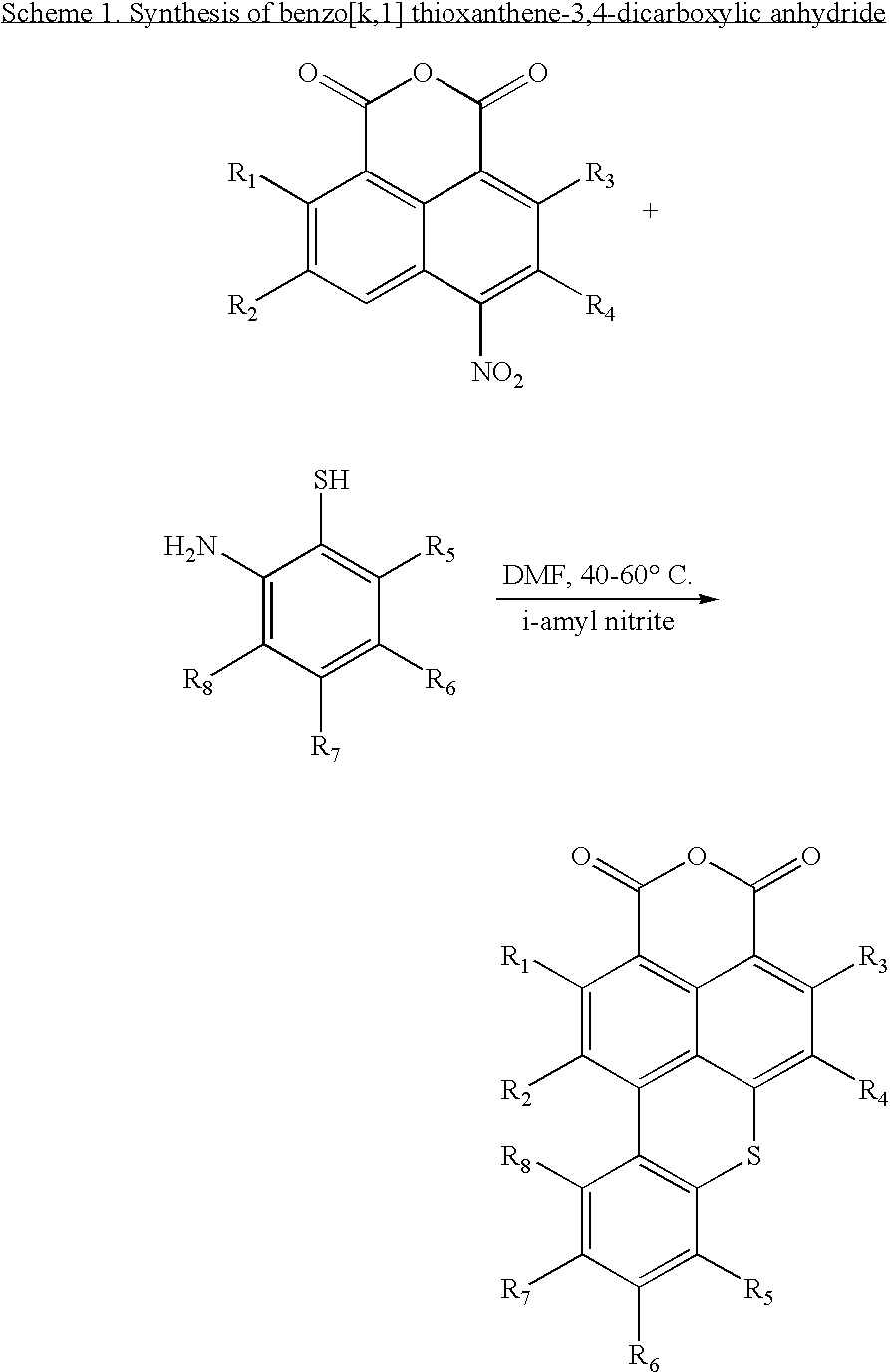Radiation curable ink containing fluorescent nanoparticles
a technology of fluorescent nanoparticles and inks, applied in inks, printing, group 5/15 element organic compounds, etc., can solve the problems of poor ink performance, poor lightfastness, and limitations of printing process by crystalline waxes, and achieve the effect of suitable thermal degradation properties
- Summary
- Abstract
- Description
- Claims
- Application Information
AI Technical Summary
Benefits of technology
Problems solved by technology
Method used
Image
Examples
example 1
[0204]Preparation of Nanoscale Fluorescent Pigment Particles
[0205]Synthesis of the Fluorescent Pigment
[0206]Benzo[k,l]thioxanthene-3,4-dicarboxylic Anhydride
[0207]In a 200 mL 3-neck round bottom flask fitted with magnetic stirrer, reflux condenser and oil bath were introduced 4 g (0.016 mol) 4-nitronaphthalene tetracarboxylic anhydride, 3 mL (0.03 mol) 2-amino-benzenethiol and 40 mL N,N-dimethyl formamide. A dark brown solution resulted. I-Amyl nitrite, 3.2 mL (0.024 mol) was added slowly, via a syringe into the flask. The temperature of the reaction mixture rose to 80° C., and an orange precipitate formed. At the end of the addition, the temperature in the flask was allowed to drop to 60° C. The reaction mixture was then stirred at this temperature for 3 hours to insure completion of the reaction. The solid was filtered through a fritted glass and washed with N,N-dimethyl formamide twice, and once with N,N-dimethyl formamide:distllled water with a weight ratio of 1:1 until the wash...
example 2
[0213]Fluorescent Organic Nanoparticles Obtained by Modified Emulsion Aggregation Latex Process
[0214](1) Preparation of Polyester Latex.
[0215]190 grams of amorphous propoxylated bisphenol A fumarate resin (Mw=12,500, Tg onset=56.9, acid value=16.7; available commercially as SPAR™ resins from Reichhold Chemicals, Inc., RESAPOL HT resin from Resana S. A. along with 10 grams (g) of DFKY-C7 (Risk Reactor) fluorescent dye were weighed out in a 1 L kettle. 100 g of methyl ethyl ketone and 40 g of isopropanol were weighed out separately and mixed together in a beaker. The solvents were poured into the 1 L kettle containing the resin. The kettle, with its cover on, a gasket, a condenser and 2 rubber stoppers, were placed inside a water bath set at 48° C. for 1 hour. The anchor blade impeller was set up in the kettle and was switched on to rotate at approximately 150 RPM. After 3 hours, when all of the resins dissolved, 8.69 g of 10% NH4OH was added to the mixture drop-wise with a disposable...
example 3
[0219]Fluorescent Organic Nanoparticles Obtained by Emulsion-Polymerization
[0220]A surfactant solution consisting of 3.0 g of Neogen RK (anionic emulsifier) and 250 g de-ionized water was prepared by mixing for 10 minutes in a stainless steel holding tank. The holding tank was then purged with nitrogen for 5 minutes before transferring into the reactor. The reactor was then continuously purged with nitrogen while being stirred at 300 RPM. The reactor was then heated up to 76° C. at a controlled rate and held constant. In a separate container, 2.13 g of ammonium persulfate initiator was dissolved in 22 g of de-ionized water. Also in a second separate container, the monomer emulsion was prepared in the following manner. 125 g of methylmethacrylate, 5 g of diethyleneglycol dimethacrylate, 6.4 g of DFKY-C7 Fluorescent Dye (Risk Reactor), 7 g Neogen RK (anionic surfactant), and 135 g of deionized water were mixed to form an emulsion. One percent of the above emulsion was then slowly fed ...
PUM
| Property | Measurement | Unit |
|---|---|---|
| particle diameter | aaaaa | aaaaa |
| particle diameter | aaaaa | aaaaa |
| degree of cross linking | aaaaa | aaaaa |
Abstract
Description
Claims
Application Information
 Login to View More
Login to View More - R&D
- Intellectual Property
- Life Sciences
- Materials
- Tech Scout
- Unparalleled Data Quality
- Higher Quality Content
- 60% Fewer Hallucinations
Browse by: Latest US Patents, China's latest patents, Technical Efficacy Thesaurus, Application Domain, Technology Topic, Popular Technical Reports.
© 2025 PatSnap. All rights reserved.Legal|Privacy policy|Modern Slavery Act Transparency Statement|Sitemap|About US| Contact US: help@patsnap.com



